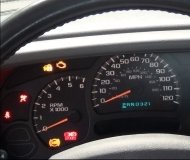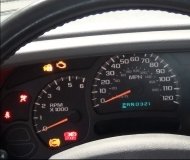Since my other reply, I removed the plastic intake plenums. I thoroughly cleaned them and cleaned and degreased the gasket surfaces and channels. I replaced all of the Plenum gaskets. Pre-coating the gaskets, gasket surfaces and channels with a moderately thin coating of high temp Silicone. Reassembled and torqued properly. Then I let the vehicle sit for 24 hours to give PLENTY of time for the silicone to cure.
I double checked all vacuum hoses and connections. I'm hoping those steps eliminates any vacuum leak concerns.
The battery was disconnected during that entire time.
When warmed up it would stumble at stop lights which was an entirely new symptom. I swapped the hoses for the DPCE and that symptom disappeared
I tested it by sitting stopped with the parking brake on and in drive lights on, for about 10 minutes. It died after about 10 minutes. Upon restart, putting it back in drive, the rpm settled at approx. 750 rpm for about 20-30 seconds, then dropped to approx 600 rpm. Then it died a few seconds later.
That same pattern would occur every time once warmed up and stopped in drive the rpm would go to around 750, then drop to 600, then some times the engine would quit after anywhere from a few seconds to a few minutes.
"Does the engine slowly sputter to a stop, or is the stalling immediate? "
It is immediate as if someone turned the ignition off.
I checked the voltages and resistances as follows:
Engine off cold.
- Bat terminal to bat connector = 0 ohms 0 vdc
- Bat connector to body = 1.3 ohms 0.001 vdc
- Bat connector to Block = 0.3 ohms 0 vdc
+Bat term to bat connector = 0 ohms, 0 vdc
+Bat connector to Alternator = 0 ohms 0 vdc
+Bat to + on Maxi Fuse = 0 ohms, 0 vdc
Engine on in drive, warmed up, lights on, after engine has stalled in drive
-Bat connector to block 0.148 vdc
-Bat connector to body 0.042 vdc
+Bat Connector to Alt = 0.224 cooling fans on, 0.139 cooling fans off.
+Bat Connector to Maxi fuse 0.042 vdc
"Last, check the PCM power relay for proper operation. It may be getting hot, or the contacts are bad, causing the PCM to lose power and thus, the engine dies."
That relay was warm, but not markedly warmer than some of the other relays. The coolest relay in the box was the one that was in the start interrupt position. I swapped the relay that was in the PCM slot with the one in the Start interrupt slot.
The relay swap was the last thing I did before coming in and writing this. The Windstar ran parked in drive with the parking brake on and chocked for about 5 minutes without stalling after the swap. I do not consider that an adequate test, so will take it out for a test drive a little later this afternoon.
Saturday, August 29th, 2009 AT 2:26 PM




